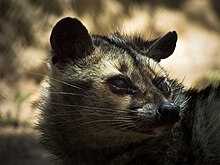Asian palm civet
The Asian palm civet (Paradoxurus hermaphroditus), also called common palm civet, toddy cat and musang, is a viverrid native to South and Southeast Asia. Since 2008, it is IUCN Red Listed as Least Concern as it accommodates to a broad range of habitats. It is widely distributed with large populations that in 2008 were thought unlikely to be declining.[2] In Indonesia, it is threatened by poaching and illegal wildlife trade; buyers use it for the increasing production of kopi luwak (civet coffee).
Distribution and habitat
The Asian palm civet is native to India, Nepal, Bangladesh, Bhutan, Myanmar, Sri Lanka, Thailand, Singapore, Peninsular Malaysia, Sabah, Sarawak, Brunei Darussalam, Laos, Cambodia, Vietnam, China, the Philippines, and the Indonesian islands of Sumatra, Java, Kalimantan, Bawean, and Siberut. It was introduced to Irian Jaya, the Lesser Sunda Islands, Maluku, and Sulawesi. Its presence in Papua New Guinea is uncertain.[2]
It usually inhabits primary forests, but also occurs at lower densities in secondary and selectively logged forest.[5]
It is also present in parks and suburban gardens with mature fruit trees, fig trees, and undisturbed vegetation. Its sharp claws allow climbing of trees and house gutters. In most parts of Sri Lanka, palm civets are considered a nuisance since they litter in ceilings and attics of common households, and make loud noises fighting and moving about at night.[citation needed]

